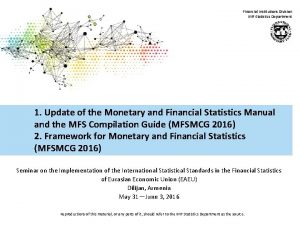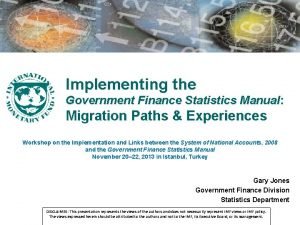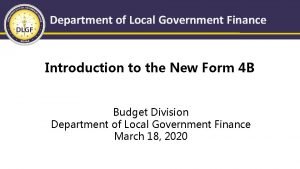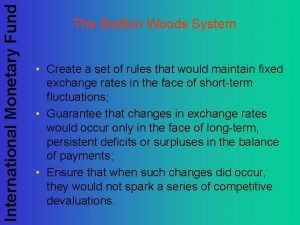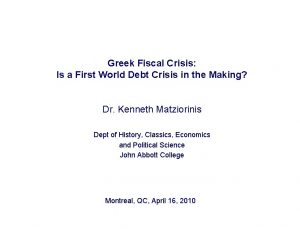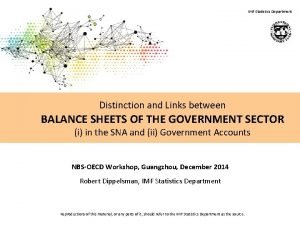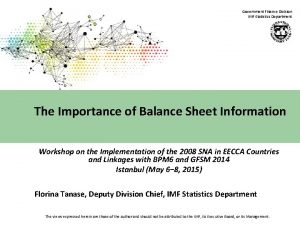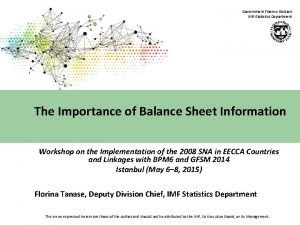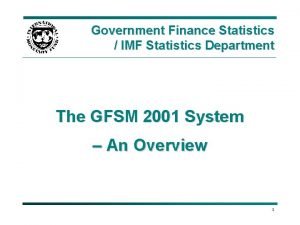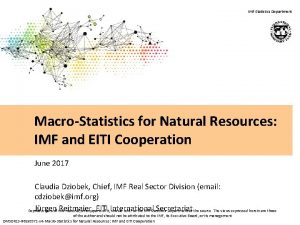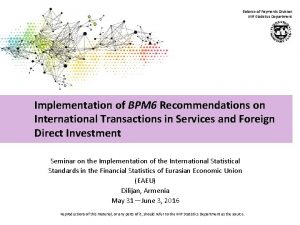Government Finance Division IMF Statistics Department Status of





















- Slides: 21

Government Finance Division IMF Statistics Department Status of Reporting of Data According to BPM 6 and GFSM 2014—Reporting of Balance Sheet Data and the IMF’s Efforts to Improve Cross-Sector Consistency of Data Workshop on the Implementation of the 2008 SNA in EECCA Countries and Linkages with BPM 6 and GFSM 2014 Istanbul (May 6– 8, 2015) Florina Tanase, Deputy Division Chief, IMF Statistics Department The views expressed herein are those of the author and should not be attributed to the IMF, its Executive Board, or its Management.

Government Finance Division IMF Statistics Department Overview Part I: Status of Reporting of Data according to BPM 6 and GFSM 2014 Part II: IMF’s Efforts to Improve Cross-Sector Consistency of Data 2

Government Finance Division IMF Statistics Department Part I: Status of Reporting of Data according to BPM 6 and GFSM 2014 3

Government Finance Division IMF Statistics Department BPM 6 Conversion § Balance of payments (BOP) and International Investment § § § Position (IIP) data on a BPM 6 basis were first released by the IMF in the August 2012 IFS and in the December 2012 BOPSY As of April 2015, 106 economies have reported their data on a BPM 6 basis. For other economies, STA continues to convert data reported on a BPM 5 basis to a BPM 6 basis, through a conversion formula agreed with the economy The BPM 6 Compilation Guide was posted in November 2014 on http: //www. imf. org/external/pubs/ft/bop/2007/bop 6 comp. h tm In October 2014, the IMF Committee on Balance of Payments Statistics agreed that the IMF will start releasing pre-2005 data on a BPM 6 basis in 2015 (currently, only data from 2005 are released) 4

Government Finance Division IMF Statistics Department International Investment Position § As of April 2015, 143 economies (including all G 20) are reporting IIP data to STA (including all G 20 economies) Quarterly IIP reporters § The number of economies reporting quarterly IIP data increased to 95 in April 2015 § 18 G 20 economies (including the Euro Area) currently report quarterly IIP data 5

Government Finance Division IMF Statistics Department International Investment Position 143 Reporters: 95 Quarterly 48 Annual 6

Government Finance Division IMF Statistics Department Coordinated Portfolio Investment Survey § The end-June 2014 CPIS survey results were posted on the IMF website in March 2015: http: //cpis. imf. org 61 economies reported the core items* * To participate in the CPIS, an economy must provide position data of its holding of securities (separately for equity, long-term debt instruments, and short-term debt instruments) broken down by the economy of residency of the issuer 7

Government Finance Division IMF Statistics Department Coordinated Portfolio Investment Survey The following CPIS enhancements were first implemented with end-June 2013 data (for 56 economies) released in March 2014: § Frequency: From annual to semiannual data § Timeliness: Dissemination reduced from 11 months to 9 months after § the measurement date Scope: On an encouraged basis, the reporting of data on: o Institutional sector of nonresident debtor (issuer) o Institutional sector of resident holder cross-classified by institutional o sector of nonresident issuer for 25 economies with systemically important financial sectors (more granular data on a “from-whom-to-whom” basis) Short (negative) positions § Economies are also encouraged to report additional detail on the currency composition of holdings, as well as on their portfolio investment liabilities. The concepts and principles underlying the CPIS are aligned with the BPM 6 8

Government Finance Division IMF Statistics Department Coordinated Direct Investment Survey § Preliminary results for end-2013 and revised data for 2009 -2012 were released in December 2014 § 91 economies reported end-2009 data, 97 end-2010 data, 103 end-2011 data, 103 end-2012 data, and 90 reported preliminary end-2013 data § New CDIS platform/portal was also launched in December 2014 (http: //data. imf. org/CDIS) § Revised Metadata questionnaire and further userfriendly query reports were made available 9

Government Finance Division IMF Statistics Department CDIS and CPIS Reporters (as of December 2014, for 2013 data) 10

Government Finance Division IMF Statistics Department External Debt Statistics § The 2013 External Debt Statistics: Guide for Compilers and Users (2013 EDS Guide) was posted in May 2014 at: http: //www. tffs. org/edsguide. htm § In October 2014, the World Bank released for the first time the 2014 Q 2 external debt statistics (QEDS) based on the 2013 EDS Guide/BPM 6 guidelines: http: //datatopics. worldbank. org/debt/home § All 71 SDDS subscribers and about 40 GDDS participants report quarterly external debt data to the QEDS 11

Government Finance Division IMF Statistics Department Government Finance Statistics § The 2014 GFSM now available at: http: //www. imf. org/external/Pubs/FT/GFS/Manual/2014 /gfsfinal. pdf § Aligned with the 2008 SNA and BPM 6 § Deepens the existing methodological guidance; and introduces some new concepts and presentations, including presentational tables on contributions to changes in net worth and on contingent liabilities 12

Government Finance Division IMF Statistics Department Growing Number of Countries Reporting to GFS Yearbook Source: Government Finance Statistics Yearbook 13

Government Finance Division IMF Statistics Department A More Transparent Presentation of Gross Debt 14

Government Finance Division IMF Statistics Department Presentation of Gross Debt: A Country Example Composition of gross government debt as a percentage of GDP 140 120 100 80 60 40 GL 3 20 GL 2 0 D 1 D 2 D 3 D 4 GL 1 15

1995 Q 1 0 D 1 D 2 D 3 2014 Q 1 2013 Q 3 2013 Q 1 2012 Q 3 2012 Q 1 2011 Q 3 2011 Q 1 2010 Q 3 2010 Q 1 2009 Q 3 2009 Q 1 2008 Q 3 2008 Q 1 2007 Q 3 2007 Q 1 2006 Q 3 2006 Q 1 2005 Q 3 2005 Q 1 2004 Q 3 2004 Q 1 2003 Q 3 2003 Q 1 2002 Q 3 2002 Q 1 2001 Q 3 2001 Q 1 2000 Q 3 2000 Q 1 1999 Q 3 1999 Q 1 1998 Q 3 1998 Q 1 1997 Q 3 1997 Q 1 1996 Q 3 1996 Q 1 1995 Q 3 Number of countries Government Finance Division IMF Statistics Department Reporting to the Quarterly Public Sector Debt Statistics Database 80 70 60 50 40 30 20 10 D 4 Source: QPSD database, World Bank. A total of 64 countries reported public sector debt statistics for 2014 Q 3. 16

Government Finance Division IMF Statistics Department GFS: Looking Forward § Promoting reporting of data on a GFSM 2014 basis by all countries § Improving data quality and filling data gaps § Greater use of GFS in macro-fiscal analysis § Newly established Government Finance Statistics Advisory Committee (first meeting during March 9 -10, 2015) to help promote compilation and use of GFS 17

Government Finance Division IMF Statistics Department Part II: IMF’s Efforts to Improve Cross. Sector Consistency of Data The views expressed herein are those of the author and should not be attributed to the IMF, its Executive Board, or its Management.

Government Finance Division IMF Statistics Department STA’s Cross-Sector Consistency Group § The Cross-Sector Consistency Group (CSCG) was established in mid-March 2012 in recognition of the importance of addressing inconsistencies in data that are reported to STA for different economic sectors § The CSCG’s main objective is to enhance the consistency of macroeconomic datasets reported to STA to facilitate economic analysis and support IMF bilateral and multilateral surveillance 19

Government Finance Division IMF Statistics Department CSCG: Key Findings § Common reasons for inconsistencies: • coverage of institutional units and/or of financial instruments • valuation of financial instruments • accrual versus cash recording • errors in source data • different time of recording; etc. § But also methodological differences between main statistical manuals 20

Government Finance Division IMF Statistics Department CSCG: Key Findings § In 2014, an expert conducted a review of: • • • System of National Accounts 2008 (2008 SNA), Balance of Payments and International Investment Position Manual (BPM 6) Draft of the combined Monetary and Financial Statistics Manual and MFS Compilation Guide (MFSMCG) Government Finance Statistics Manual 2014 (GFSM 2014) (prepublication draft) Handbook on Securities Statistics (HSS) (pre-publication draft) § The expert’s findings were taken into account in the final version of the GFSM 2014 released in March 2015; and are being incorporated in the final version of the MFSMCG that is near completion 21
 Imf financial statistics
Imf financial statistics Imf financial statistics
Imf financial statistics Government finance statistics manual
Government finance statistics manual Department of local government finance
Department of local government finance Imf history
Imf history Imf adalah
Imf adalah Imf chem
Imf chem Difference between imf and world bank
Difference between imf and world bank Materi lembaga keuangan internasional
Materi lembaga keuangan internasional Imf functions
Imf functions India imf loan history
India imf loan history Imf practice
Imf practice Wto objectives
Wto objectives Imf chemistry
Imf chemistry Imf system
Imf system Debt imf
Debt imf Lambang imf
Lambang imf Imf chemistry
Imf chemistry Imf
Imf Imf
Imf Imf
Imf Imf gdp per capita
Imf gdp per capita

